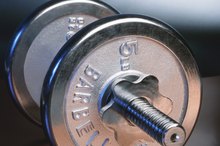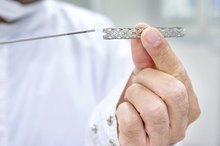Exercise With an Abdominal Aortic Aneurysm
An aneurysm is a pathologic dilatation of a blood vessel due to weakening of the vessel’s wall. The abdominal aorta is a major artery, which arises directly from the heart and supplies blood to the bottom half of your body. Abdominal aortic aneurysms are usually asymptomatic until serious complications arise. If you have been diagnosed with this type of aneurysm, it is important for you to be aware of the risks associated with exercise, including rupture or dissection of the aortic artery.
If you are experiencing serious medical symptoms, seek emergency treatment immediately.
Abdominal Aortic Aneurysms
Abdominal aortic aneurysms, or AAAs, are found in 2 percent of men older than the age of 55 and the male to female ratio of occurrence is 8-to-1. The root cause of aneurysms involves damage to the walls of blood vessels. Tobacco smoking and atherosclerosis are two well-established causes of vascular damage, which can lead to an AAA. Once the vessel wall has been weakened, elevated pressures within the artery may produce the ballooning and pathologic dilatation associated with aneurysms. Hypertension is a common source of this elevated pressure. Other hereditary conditions, which lead to vessel weakness, have been associated with AAAs as well.
- Abdominal aortic aneurysms, or AAAs, are found in 2 percent of men older than the age of 55 and the male to female ratio of occurrence is 8-to-1.
- Tobacco smoking and atherosclerosis are two well-established causes of vascular damage, which can lead to an AAA.
Natural Progression of AAAs
What Are the Signs and Symptoms of a Stomach Aneurysm?
Learn More
Once an aneurysm has formed, the artery will continue to increase in diameter; this is done to relieve the stress placed on it by the high blood pressure. Unfortunately, this means that aneurysms have a tendency to keep growing until they eventually rupture. When this occurs, the patient experiences excruciating pain in the chest and abdomen, which radiates to the back as blood enters the abdominal cavity. According to MayoClinic.com, these patients typically present with severe hypotension and require emergency surgery to prevent them from bleeding out internally. AAAs can be detected before progressing to this point either with ultrasound or with a stethoscope placed on the abdomen.
- Once an aneurysm has formed, the artery will continue to increase in diameter; this is done to relieve the stress placed on it by the high blood pressure.
Prevention
AAAs can be detected before progressing to the point of rupture. This can be accomplished either with ultrasound or by listening with a stethoscope on the abdomen. When your physician performs routine physical exams, she will likely listen for sounds of turbulence in your abdominal aorta. Also known as a bruit, these abnormal sounds coming from abdominal aneurysms are due to the chaotic movement of blood through the dilated portion of the artery.
- AAAs can be detected before progressing to the point of rupture.
- Also known as a bruit, these abnormal sounds coming from abdominal aneurysms are due to the chaotic movement of blood through the dilated portion of the artery.
Exercise with AAA
How to Dissolve Blood Clots With Exercise
Learn More
The root problem with AAAs is a weak vessel wall combined with high blood pressure. If you have been diagnosed with this condition, or there is a family history of aneurysms and dissections, it is important to perform low intensity exercise to avoid increasing your blood pressure to dangerous levels. A 2003 study in "JAMA" recommends patients with known aneurysms to exercise with extreme caution 1. The study recommends limiting activities such as weight lifting because of the elevated risk of dissection.
- The root problem with AAAs is a weak vessel wall combined with high blood pressure.
Applications
Exercise is an important part of maintaining health and the presence of an abdominal aortic aneurysm should not stop you from doing so. In fact, exercise can be helpful in reversing the processes that caused the aneurysm in the first place: namely, atherosclerosis and hypertension. Low intensity aerobic exercise will help you manage these underlying conditions and will present minimal risk for dissection of your AAA.
Related Articles
References
- "JAMA": Weight Lifting and Rupture of Silent Aortic Aneurysm; John Elefteriades, et.al; 2003
- “Harrison’s Internal Medicine: Diseases of the Aorta”; Mark Creager and Joseph Loscalzo; 2010
- Kumar Y, Hooda K, Li S, Goyal P, Gupta N, Adeb M. Abdominal aortic aneurysm: pictorial review of common appearances and complications. Ann Transl Med. 2017;5(12):256. doi:10.21037/atm.2017.04.32
- American College of Cardiology. The Genetics of Aortic Aneurysms
- Töpel I, Zorger N, Steinbauer M. Inflammatory diseases of the aorta: Part 1: Non-infectious aortitis. Gefasschirurgie. 2016;21(Suppl 2):80-86. doi:10.1007/s00772-016-0143-9
- Overview of infected (mycotic) arterial aneurysm
- National Heart, Lung, and Blood Institute. Aortic Aneurysm
- Gish DS, Baer JA, Crabtree GS, Shaikh B, Fareedy SB. Impending aortic aneurysm rupture - a case report and review of the warning signs. J Community Hosp Intern Med Perspect. 2016;6(5):32217. doi:10.3402/jchimp.v6.32217
- Geisbüsch S, Stefanovic A, Schray D, Et Al. A Prospective Study Of Growth And Rupture Risk Of Small-To-Moderate Size Ascending Aortic Aneurysms. J Thorac Cardiovasc Surg 2014; 147:68.
- Kuzmik Ga, Sang Ax, Elefteriades Ja. Natural History Of Thoracic Aortic Aneurysms. J Vasc Surg 2012; 56:565.
- Lo Rc, Lu B, Fokkema Mt, Et Al. Relative Importance Of Aneurysm Diameter And Body Size For Predicting Abdominal Aortic Aneurysm Rupture In Men And Women. J Vasc Surg 2014; 59:1209.
- Sweeting Mj, Thompson Sg, Brown Lc, Et Al. Meta-Analysis Of Individual Patient Data To Examine Factors Affecting Growth And Rupture Of Small Abdominal Aortic Aneurysms. Br J Surg 2012; 99:655.
- Yiu Rs, Cheng Sw. Natural History And Risk Factors For Rupture Of Thoracic Aortic Arch Aneurysms. J Vasc Surg 2016; 63:1189.
Writer Bio
I have completed the first two years of medical school, during which time I have developed expertise in writing on medical and science topics for eHow and Livestrong. My blog, cAMPScience.org, has recently been approved at DMS for "Blogger" status, which will allow me to continue to develop my brand with this organization. I will provide high quality articles, using only the best sources in medical and science research.








